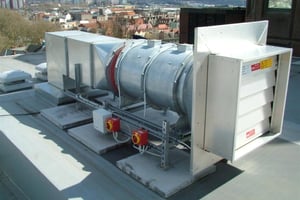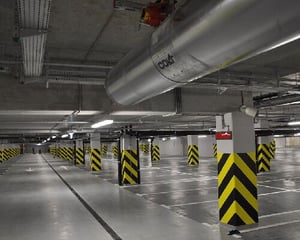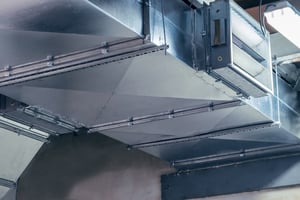 Every day, our technical consultants and designers deal with a wide range of projects and challenges that require specific knowledge and expertise in smoke control design and installation.
Every day, our technical consultants and designers deal with a wide range of projects and challenges that require specific knowledge and expertise in smoke control design and installation.
To help us share some of this knowledge with you, we asked them to compile a set of questions and answers for the most frequently queried topics from customers - we ended up with eight subjects:
Car Park Ventilation
Natural vs. Mechanical Ventilation
Smoke Control & Fire Dampers
Environmental Ventilation
CFD (Computational Fluid Dynamics)
The Components of a Smoke Control System
When Do You Need Smoke Control in a Building?
Pressurization Systems
In part 1 of this blog, we will cover Car Park Ventilation, Natural vs. Mechanical Ventilation, Smoke Dampers and Environmental Ventilation. To get an email notification when Part 2 is released, subscribe to our blog.
Car Park Ventilation
 Why is car park ventilation required?
Why is car park ventilation required?
Car park ventilation is usually required to remove a build-up of fumes (released from vehicle exhausts), to keep heat or temperature released from the vehicles at manageable levels or, in a worst-case scenario, a smoke ventilation system will remove smoke from a car park fire out of the building, enabling a safe escape for anyone in the car park at the time.
How do you ventilate a car park?
All car parks can be categorised in three different ways:
- An enclosed car park, such as a basement or underground car park
- A partially enclosed car park, where there are some openings to outside
- An open-sided car park, which is open to atmosphere
For basement and underground car parks, you would require high temperature extract fans to remove fumes and/or smoke and a way to move air around the building – typically this can be achieved with jet fans.
For a partially enclosed car park with some openings to outside, you may only need a set of ambient rated air movement fans (or possibly just the jet fans) as it is not always necessary to have the extract fans.
For open-sided car parks, because there are so many openings to the outside, wind will usually be sufficient to ventilate the car park without the help of any mechanical systems.
Natural vs. Mechanical Smoke Ventilation
 What is natural smoke ventilation?
What is natural smoke ventilation?
Natural ventilation uses the natural characteristics of smoke, such as buoyancy to extract it from a building as smoke travels on its own accord.
What is mechanical ventilation?
The purpose of mechanical systems is the same as for natural systems – to extract smoke. However, mechanical ventilation systems use fans at the top of a smoke shaft to ventilate the smoke out of the building. The size and type of fan that is required depends on a host of different factors, for example the type or use of the building and its height. The performance is mostly objective driven and demonstrated through Computational Fluid Dynamics modelling.
Why would you choose one system type over the other?
There are important things to consider when selecting your system type. More often than not, a natural system will be cheaper than a mechanical one. However, sometimes the shape and size of a building will determine that a natural solution is not practicable and that a mechanical system is required.
Natural Automatic Opening Vents (AOVs) have a building height application limit, while Natural Shaft Systems may require a bigger shaft footprint (than a mechanical solution), so if space is an issue, mechanical systems are often the better choice. Extended corridors will normally require a higher level of performance to compensate for longer escape distances. This is not easy to demonstrate with a natural system, so in this instance as well, a mechanical system would need to be used with a supply and extract shaft at either end of the corridor.
What are the most important things to consider when deciding what smoke control system type to choose?
- What the system is trying to achieve
- Type and size of the building
- Space available
Smoke Control Dampers:
 What is a smoke control damper?
What is a smoke control damper?
A smoke control damper is a device that is used to prevent the movement of smoke and fire from one area to another (when the damper is closed), but that can also allow the effective ventilation of smoke in the event of a fire (when the damper is opened). When the damper is closed it should remain closed and when open it should remain open - there is no 'failsafe' position.
What is an MFSD?
An MFSD (motorised fire and smoke damper) is similar to a smoke control damper in that it prevents the movement of fire and smoke from one area to another. The key difference is that the MFSD fails to the closed position and stays closed the entire time if there is a fire. Therefore, these cannot be used for smoke ventilation.
What are the requirements for fire and smoke control dampers?
Smoke control dampers have to be certified to BS EN12101-8, which involves fire resistance tests, maintenance of opening tests, air leakage tests and also some reliability testing. MFSDs are slightly different because they don’t have the maintenance of opening test requirement (as they do not open) and the standard they need to work to is BS EN15650.
When it comes to installation, the entire install has to be exactly as it was tested – if there are any changes then the whole arrangement could be considered uncertified (although there are a few very exceptional circumstances).
Damper sizing must be looked at carefully, because if the dampers are not big enough in a natural ventilation system, it could be considered non-compliant. If they are too small in a mechanical system, it could mean you have large, inefficient fans or the system will not be able to achieve its designed duty.
Environmental Ventilation
What is environmental ventilation?
Environmental ventilation is primarily used in residential buildings to control overheating in common corridors. Typically, the common corridors of a residential building are well sealed and well insulated to comply with energy conservation requirements. The building’s mechanical and electrical heating services also run through the ceiling void and they emit heat. This, combined with heat generated in the apartments can cause an unpleasant, stuffy atmosphere in the corridors - an environmental ventilation system can be designed to remove heat and stale air from the corridors, and allow fresh air in, making the conditions much more agreeable. More sophisticated solutions add cooling and filtration to the incoming air.
Can I use a smoke control system to provide environmental ventilation?
Yes, smoke control systems can be the ideal solution for environmental ventilation. If you have a natural smoke control system, you can simply open the AOV directly to outside, which allows some hot air out of the building and some fresh air into the building. If you have a natural smoke shaft, opening the dampers into the smoke shaft will act as a big chimney, releasing the hot air to outside.
If you have a mechanical smoke control system, you can run the fans at a low speed to suck some of the warm air out of the building or you can provide some dedicated low-speed day-to-day fans, which are more efficient for environmental ventilation.
Whichever solution is adopted, it must respect the compartmentation and fire separation of the building by using the right type of dampers and of course, the smoke control function should not be compromised.
That’s it for part 1 of the blog series, thanks for reading. If you found this useful, don’t forget to subscribe to our blog to receive a notification of the second instalment.
For more information on any of the above topics, please get in touch with one of our technical consultants by emailing info@coltinfo.co.uk or calling us on 02392 451111.
 Conor Logan is Associate Technical Director of Colt UK, Smoke and Climate Control Division. Conor designs innovative smoke control and HVAC systems and was Chairman of the Smoke Control Association for over 9 years.
Conor Logan is Associate Technical Director of Colt UK, Smoke and Climate Control Division. Conor designs innovative smoke control and HVAC systems and was Chairman of the Smoke Control Association for over 9 years.


